The Birth of Esau and Jacob (illumination by Master of Jean de Paris, from a Bible Historiale circa 1360–1370, at the J. Paul Getty Museum)
Detail
The Birth of Esau and Jacob (illumination by Master of Jean de Paris, from a Bible Historiale circa 1360–1370, at the J. Paul Getty Museum)
Master of Jean de Mandeville, French, active 1350 - 1370. The Master of Jean de Mandeville, an anonymous French illuminator, is thus known for his work on a manuscript of Mandeville's Travels now in the Bibliothèque Nationale, Paris. A prolific court artist, he worked in France in the circle of King John the Good and King Charles V from around 1350 to 1370. He often painted the costumes of his slight figures in grisaille and rendered the figures' faces and hands in flesh tones with touches of color. Many Parisian illuminators of the day shared this partially monochrome style. More Master of Jean de Mandeville
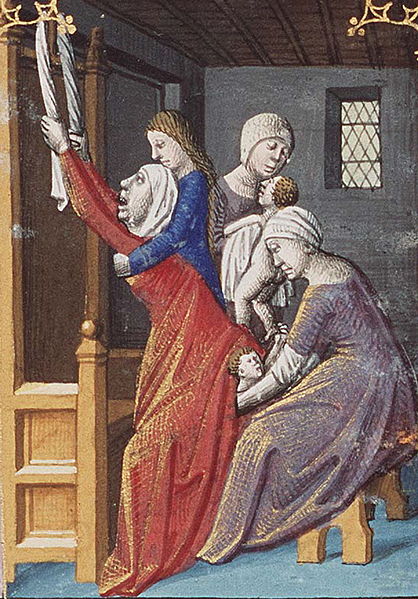
François Maitre, circa 1475-1480
Birth of Esau and Jacob as an example of twin's fate against the arguments of astrology
detail from miniature at the Museum Meermanno Westreenianum, The Hague
from Augustine's "La Cité de Dieu", book I-X, circa 1475 and circa 1480
The Maître François is an anonymous master illuminator active in Paris between 1462 and 1480. It was identified in a artist named François Le Barbier, documented from 1455 to 1472. More
Jacob was the second-born of the twin sons of Isaac and Rebekah, and the grandson of Abraham and Sarah. Jacob was a quiet and peaceful man, in contrast to his slightly older brother Esau who was often foolhardy and irresponsible.

Jan Victors, 1619 - 1679
Isaac and Rebecca with Jacob and Esau, c. 1652
215 x 347 cm
Oil on canvas
Jan Victors or Fictor (bapt. June 13, 1619 – December 1679) was a Dutch Golden Age painter that focused mainly on painting subject from the Bible. Victors was born in Amsterdam. He was known in Haarlem on a taxation catalog in 1722 as a student of Rembrandt van Rijn. Though it is not certain that he worked for Rembrandt, it is clear from his Young girl at a window that he had looked carefully at Rembrandt's paintings. He was only twenty when he painted this scene, and the look of expectation on the girl's face shows a remarkable study of character. Like many painters in Amsterdam after the rampjaar of 1672, he fell onto bad times and took a position as ziekentrooster, a combi-job as professional nurse and cleric, with the Dutch East India Company in 1676. He died soon after arrival in Indonesia, then the Dutch East Indies.
He was a conscientious member of the Reformed Church, and for this reason he avoided creating art which depicts Christ, angels, or nudity. More
Laban was the son of Bethuel, the son of Nahor, who was Abraham's brother. He lived in Haran, a city in Mesopotamia. Laban's sister was Rebekah, who married Isaac; Laban was therefore Jacob's uncle.
The struggle between Jacob and his fraternal-twin brother Esau began literally from before their birth. Esau, the firstborn by a few minutes, later foolishly sold his birthright to Jacob.
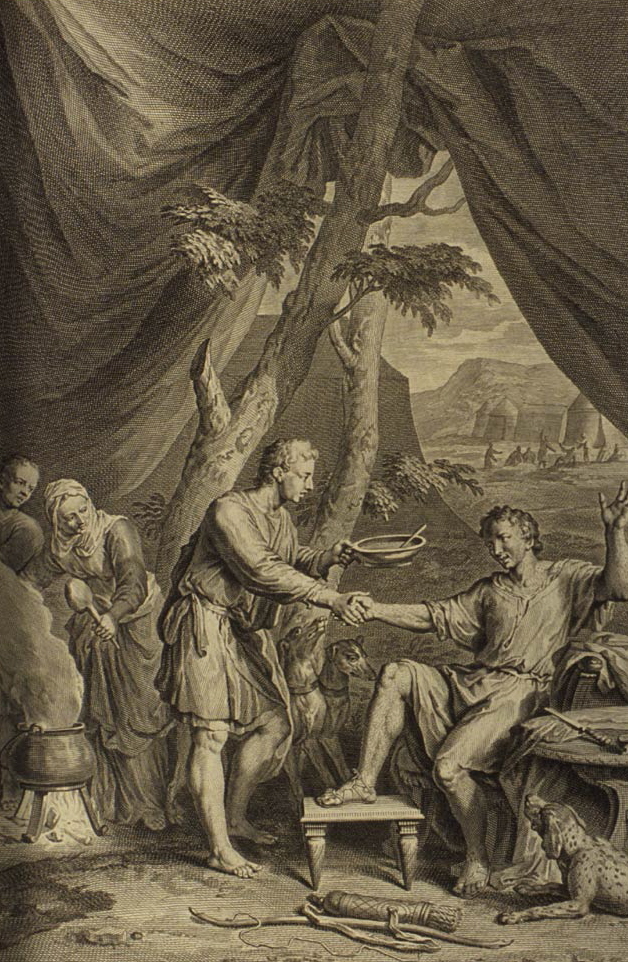
Gerard Hoet, (1648-1733)
Esau Sells His Birthright for Pottage of Lentils
as in Genesis 25:32-33, "And Esau said, Behold, I am at the point to die: and what profit shall this birthright do to me? And Jacob said, Swear to me this day; and he sware unto him: and he sold his birthright unto Jacob."; illustration from the 1728 Figures de la Bible; illustrated by Gerard Hoet (1648-1733) and others, and published by P. de Hondt in The Hague; image courtesy Bizzell Bible Collection, University of Oklahoma Libraries
Gerard Hoet (Dutch: [ɦut]; 22 August 1648 – 2 December 1733) was a Dutch Golden Age painter and engraver. Hoet trained with his father and brother who were glass painters, and Warnard van Rijsen, who lived in Zaltbommel, and who himself was a pupil of Cornelis van Poelenburgh in Utrecht. In 1672 Hoet moved to The Hague, but when the Count of Salis bought his paintings at his mother's house in Zaltbommel, Hoet returned to paint for him. More
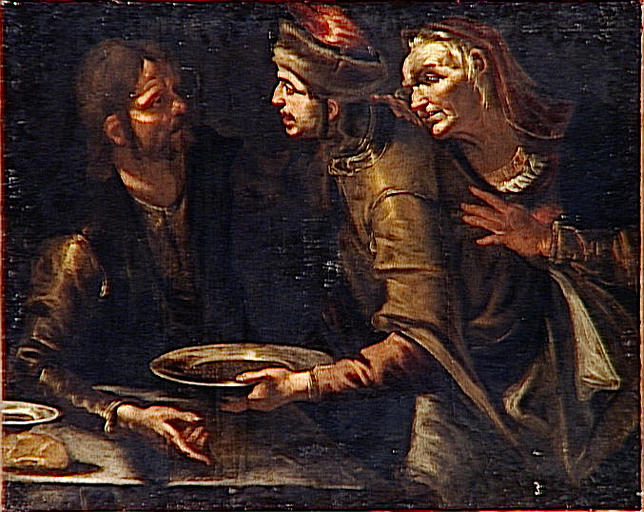
After Gioacchino Assereto, 1600 - 1649
Jacob offers a dish of lentels to Esau for the birthright, c. 17th century
Oil on canvas
Musée du Louvre, Paris, France
Gioacchino Assereto (1600 – 28 June 1649) was an Italian painter of the early Baroque period, active in Genoa. He initially apprenticed with Luciano Borzone and later Giovanni Andrea Ansaldo. He painted two vault frescoes in the church of Santissima Annunziata del Vastato: David and Abimelech and Santi Giovanni and Pietro healing the lame. He also shows the influence of Bernardo Strozzi, a tenebrism moderated by venetian coloristic effects and garbing the subjects in modern peasant garb. More
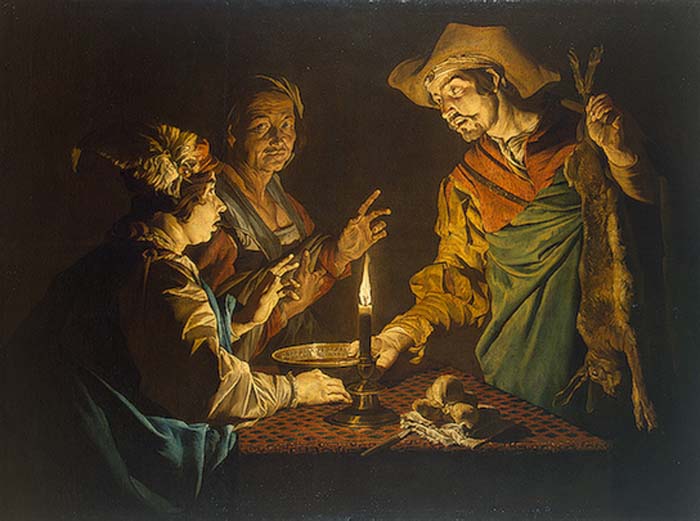
Matthias Stom, 1600 - 1652
Selling the Birthright, c. 1640
Oil on canvas
He remained in Rome until 1632, after which he traveled to Naples, where he stayed until 1640. He then moved to Palermo, and delivered paintings for churches in Caccamo and Monreale. He sold three paintings to Antonio Ruffo, duke of Messina. It is speculated that he died in Sicily, or alternatively in Northern Italy, where in 1652 he painted an altar piece for the church in Chiuduno. More

Circle of Matthias Stom, (fl. 1615–1649)
Esau sold Jacob his birthright or the stew, c. 17th century
Oil on canvas
96 x 117 cm

Hendrick ter Brugghen, (1588–1629)
Esau selling his birthright, circa 1627
Oil on canvas
Height: 106.7 cm (42 in). Width: 138.8 cm (54.6 in).
Thyssen-Bornemisza Museum, Madrid, Spain
Hendrick Jansz ter Brugghen (or Terbrugghen) (1588 – 1 November 1629) was a painter at the start of Dutch Golden Age, and a leading member of the Dutch followers of Caravaggio–the so-called Utrecht Caravaggisti. Along with Gerrit van Hondhorst and Dirck van Baburen, Ter Brugghen was one of the most important Dutch painters to have been influenced by Caravaggio. More
Jacob, at the instigation, and assistance, of his mother Rebekah, deceived the then-blind Isaac into also giving Jacob the blessing that would otherwise have gone to Esau.

José de Ribera, (1591–1652)
Isaac Blessing Jacob, c. 1637
Oil on canvas
129 × 289 cm (50.8 × 113.8 in)
Prado Museum, Madrid, Spain
José de Ribera (January 12, 1591 – September 2, 1652) was a Spanish Tenebrist painter and printmaker, better known as Jusepe de Ribera. He also was called Lo Spagnoletto ("the Little Spaniard") by his contemporaries and early writers. Ribera was a leading painter of the Spanish school, although his mature work was all done in Italy. More

Govert Flinck, (1615–1660)
Isaac blessing Jacob, c. 1638
Oil on canvas
Height: 117 cm (46.1 in). Width: 141 cm (55.5 in).
Rijksmuseum, Amsterdam
Govert Flinck, (born January 25, 1615, Kleve, Brandenburg [Germany]—died February 2, 1660, Amsterdam, Dutch Republic [now in the Netherlands]) Baroque painter of portraits, genre, and narrative subjects, one of Rembrandt’s most-accomplished followers.
Flinck first studied in Leeuwarden and later entered Rembrandt’s studio. As a painter of biblical and allegorical subjects, he at first modeled his style closely on Rembrandt’s, as, for example, in his Isaac Blessing Jacob (1638). Later he developed a more florid and oratorical manner, in which he appears to have been influenced by Peter Paul Rubens, as in the Allegory in Memory of Prince Frederick Henry (1654). Flinck’s most successful works were portraits, and he was especially successful in his group portraits—e.g., A Goldsmith and His Family and Celebration of the Civic Guard at the Signing of the Peace of Münster (1648). More
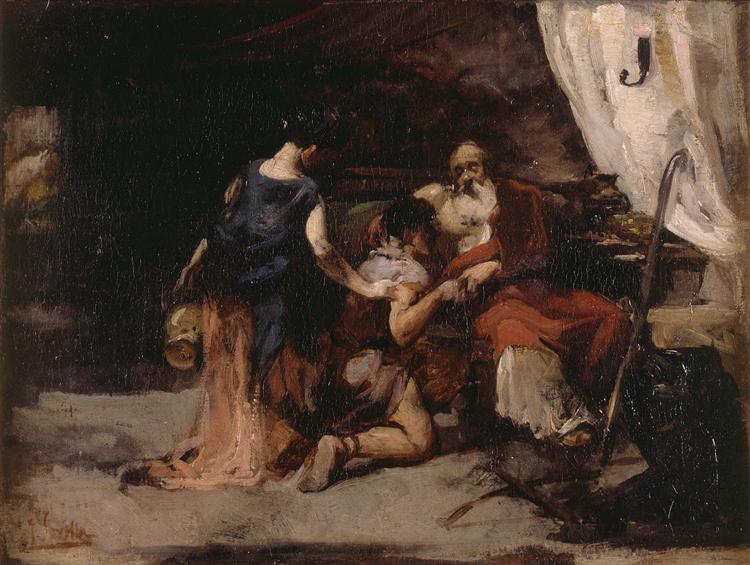
Joaquín Sorolla, 1863 - 1923
Blessing Of Isaac
Oil, canvas
31 x 41 cm
Joaquín Sorolla y Bastida (27 February 1863 – 10 August 1923) was a Spanish painter. Sorolla excelled in the painting of portraits, landscapes, and monumental works of social and historical themes. His most typical works are characterized by a dexterous representation of the people and landscape under the sunlight of his native land. More
That was the final straw for Esau, who vowed to kill Jacob, but when Rebekah heard of the threat, she sent Jacob to far away Haran to live with her brother Laban. It was apparently intended only as a short-term absence, but it lasted twenty years.

Horst, Gerrit Willemsz, (c.1612 - 1652)
Isaac blessing Jacob, c. 1638
Oil on canvas
Height: 1,632 mm (64.25 in). Width: 2,013 mm (79.25 in).
Dulwich Picture Gallery
Gerrit Willemsz Horst (1612–1652) was a Dutch Golden Age painter from the Northern Netherlands. Horst was born in Muiden and became a pupil of Antonie Hendricksz Lust in June 1626. He is also recorded as a pupil of Rembrandt during the years 1635/1640. He died in Amsterdam. More

Gioacchino Assereto, (1600–1649)
Isaac Blessing Jacob, c. 1640s
Oil on canvas
Height: 131 cm (51.6 in). Width: 178 cm (70.1 in).
Hermitage Museum,
At the outskirts of Haran, Jacob found shepherds resting near a well, watching their flocks. Jacob greeted them and asked them about the town and his uncle Laban. Just then, Rachel, Laban’s daughter, arrived with her father’s herds.

Raphael, (1483–1520)
Jacob's Encounter with Rachel, c. 1518 and 1519
Fresco
Raphael Loggia
Raphael was enormously productive, running an unusually large workshop and, despite his death at 37, leaving a large body of work. Many of his works are found in the Vatican Palace, where the frescoed Raphael Rooms were the central, and the largest, work of his career. The best known work is The School of Athens in the Vatican Stanza della Segnatura. After his early years in Rome much of his work was executed by his workshop from his drawings, with considerable loss of quality. He was extremely influential in his lifetime, though outside Rome his work was mostly known from his collaborative printmaking.
After his death, the influence of his great rival Michelangelo was more widespread until the 18th and 19th centuries, when Raphael's more serene and harmonious qualities were again regarded as the highest models. His career falls naturally into three phases and three styles, first described by Giorgio Vasari: his early years in Umbria, then a period of about four years (1504–1508) absorbing the artistic traditions of Florence, followed by his last hectic and triumphant twelve years in Rome, working for two Popes and their close associates. More
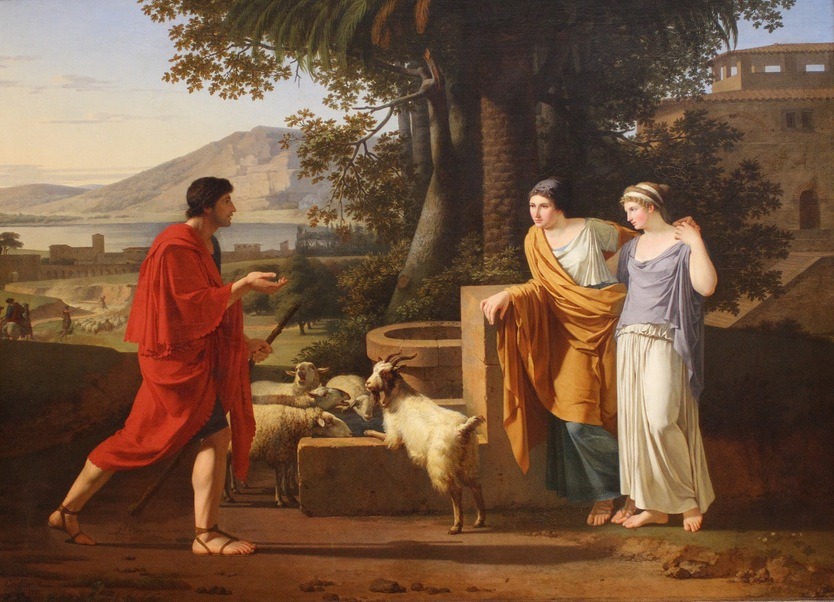
Louis Gauffier, 1762 - 1801
Jacob with the daughters of Laban, 1787
Oil on canvas
Louis Gauffier (1762–1801) was a French painter. Born in Poitiers, he studied in Paris with the history painter Hughes Taraval before entering the Prix de Rome competition which he won in 1779. Apart from a brief return to Paris in 1789 he remained in Italy for the remainder of his life. Gauffier initially settled in Rome, but popular unrest following the execution of Louis XVI led him to flee with his wife to Florence. He could not receive patronage from France because he was branded a royalist, and this curtailed his career as a history painter. Instead, he painted landscapes, which he sold to English tourists. When French troops occupied Florence in 1799, he began to paint officers' portraits. More
Jacob inquired why the shepherds did not water their flocks while it was still day. She said that only the concerted efforts of all the shepherds could remove the rock that covered the mouth of the well. Hearing this, Jacob walked over to the well and rolled the stone from its place.
Sebastiano Conca, 1680 - 1764
Jacob and Rachel at the well
Oil on Canvas
Sebastiano Conca, (born Jan. 8, 1680, Gaeta, Kingdom of Naples [Italy]—died Sept. 1, 1764, Naples) late Neapolitan Baroque painter who created great, animated compositions, superficial in content but dazzling in colour and in execution.
Conca studied in Naples under Francesco Solimena. In 1706, along with his brother Giovanni, who acted as his assistant, he settled in Rome. He was patronized by Cardinal Pietro Ottoboni, who introduced him to Pope Clement XI. The pope commissioned him to paint frescoes in San Clemente and San Giovanni in Laterano and The Crowning of St. Cecilia in Santa Cecilia in Trastevere (1725). His pictures in the grand manner were also sought by the royalty of Spain, Portugal, and Poland and by the elector of Cologne. He returned to Naples in 1751, where he executed more religious frescoes. More
Maestro dei dodici apostoli, ( Ferrara, 1520 - Ferrara, 1575 )
Jacob and Rachel at the Well
The Maestro dei dodici Apostoli (Master of the Twelve Apostles) is an anonymous Italian painter of the xvith century, active in Ferrara and Rovigo from 1530 to 1542 .
Then he watered the herds of his uncle. Rachel was overjoyed to hear that this outstanding visitor was none other than her own cousin, the son of her father’s sister. She hurried home to tell her father about Jacob’s arrival, and Laban went out to the well to greet his nephew and welcome him into his home.

Attributed to Pietro da Cortona, (Italian, 1596–1669)
The meeting of Jacob and Laban
Oil on Canvas
206 x 170 cm. (81.1 x 66.9 in.)
Pietro da Cortona (1 November 1596/7 – 16 May 1669) was born Pietro Berrettini, but is primarily known by the name of his native town of Cortona in Tuscany. He was the leading Italian Baroque painter of his time and, along with his contemporaries and rivals Gian Lorenzo Bernini and Francesco Borromini, was one of the key figures in the emergence of Roman Baroque architecture. He was also an important designer of interior decorations.
Cortona worked mainly in Rome and Florence. He is best known for his frescoed ceilings such as the vault of the salone or main salon of the Palazzo Barberini in Rome and carried out extensive painting and decorative schemes for the Medici family in Florence and for the Oratorian fathers at the church of Santa Maria in Vallicella in Rome. He also painted numerous canvases. Only a limited number of his architectural projects were built but nonetheless they are as distinctive and as inventive as those of his rivals. More

Restout, Jean II, (1692-1768)
Jacob and Laban, c. before 1737
Oil on canvas
83.5x67.5
Musee des Beaux-Arts, Rouen, France
Jean II Restout (26 March 1692 – 1 January 1768) was a French painter, whose late baroque classicism rendered his altarpieces, such as the Death of Saint Scholastica an "isolated achievement" that ran counter to his rococo contemporaries. He was born in Rouen, the son of Jean I Restout and Marie M. Jouvenet, sister and pupil of the then well-known painter Jean Jouvenet.
In 1717, the Académie Royale de Peinture et de Sculpture having elected him a member on his work for the Prix de Rome, he remained in Paris, instead of proceeding to Italy, exhibited at all the salons, and filled successively every post of academical distinction. His works, chiefly altar-pieces (Louvre Museum), ceilings and designs for Gobelin tapestries, were engraved by Charles-Nicolas Cochin, Drevet and others.
His son, Jean-Bernard Restout (1732–1797), won the Prix de Rome in 1758, and on his return from Italy was received into the Academy; but his refusal to comply with rules led to a quarrel with that body. Roland appointed him keeper of the Garde Meuble. More

Dante Gabriel Rossetti, 1828–1882
Dante’s Vision of Rachel and Leah, c. 1855
Watercolour on paper
352 x 314 mm
Tate
Dante Gabriel Rossetti, 1828–1882, see below
Jacob's family struggle didn't end when he arrived in Haran however. It wasn't long before he and his uncle Laban began looking to get the best of each other. First, Jacob agreed to work seven years to be able to marry Laban's daughter Rachel, but when the time was completed, Laban pulled a switch of Leah for Rachel.
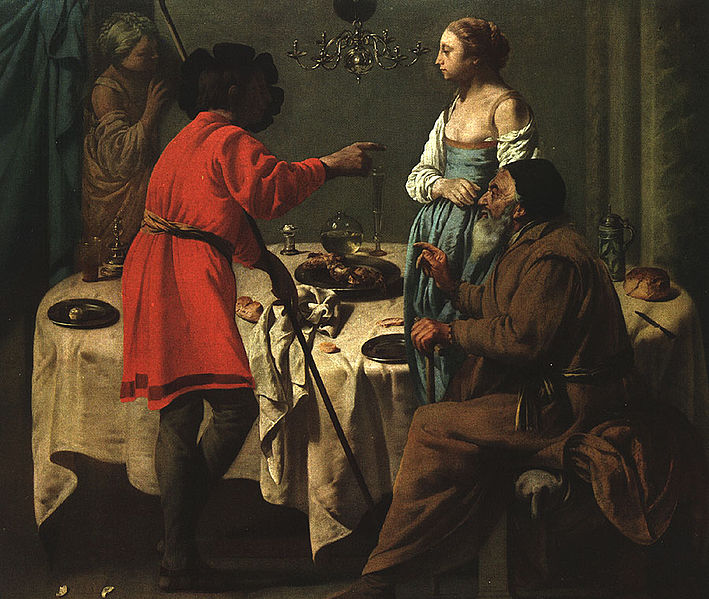
Hendrick ter Brugghen, (1588–1629)
Jacob reproaching Laban for giving him Leah in place of Rachel, c. 1627
Oil on canvas
Height: 97.5 cm (38.4 in). Width: 114.3 cm (45 in).
Current location
National Gallery, London, United Kingdom
Hendrick Jansz ter Brugghen (or Terbrugghen) (1588 – 1 November 1629) was a painter at the start of Dutch Golden Age, and a leading member of the Dutch followers of Caravaggio–the so-called Utrecht Caravaggisti. Along with Gerrit van Hondhorst and Dirck van Baburen, Ter Brugghen was one of the most important Dutch painters to have been influenced by Caravaggio. More
When Jacob protested, Laban offered Rachel also - for another seven years of work, to which Jacob agreed.
Reproaching Laban, c. 1628
Oil on canvas
123,5 x 157,5 cm
Wallraf-Richartz Museum, Cologne
The painting depicts the scene when Jacob accuses Laban of giving him to wife Leah instead of Rachel
Hendrick ter Brugghen (1588–1629), see above
Jacob Encountering Rachel with her Father's Herds, c. 1936
Oil on canvas
Height: 66 cm (26 in). Width: 92 cm (36.2 in).
Austrian Gallery Belvedere
The artist suggests that Leah was present at the meeting of Jacob and Rachel, but went unnoticed. On the other hand, there is no mention of Laban's wife, the mother of these girls in the Bible. It is possible she is already dead, and Leah has assumed responsibility for running the household. It would be a heavy burden for a young woman, since a household included not just the immediate family but relatives and servants as well. More
Joseph von Führich (February 9, 1800 – March 13, 1876) was an Austrian painter, one of the Nazarenes. He was born at Kratzau (Czech: Chrastava) in Bohemia. Deeply impressed as a boy by rustic pictures adorning the wayside chapels of his native country.
Führich became a pupil at the Academy of Prague in 1816. His first inspiration was derived from the prints of Dürer and Peter von Cornelius. In 1826 he went to Rome, where he added three frescoes to those executed by Cornelius and Overbeck in the Casino Massimo, showing scenes from Torquato Tasso's Gerusalemme liberata.
Führich was an adherent of the Nazarene movement, a romantic religious artist who sought to restore the spirit of Dürer and give new shape to biblical subjects. Without the power of Peter von Cornelius or the grace of Johann Friedrich Overbeck, he composed with great skill, especially in outline. His mastery of distribution, form, movement and expression was considerable. In its peculiar way his drapery was perfectly cast.
In 1831 he finished the "Triumph of Christ", later in the Raczynski palace at Berlin. In 1834 he was made custos and in 1841 professor of composition in the Academy of Vienna. After this he completed the monumental pictures of the church of St Nepomuk, and in 1854–61 a vast series of wall paintings which cover the inside of the Lerchenfeld church at Vienna. In 1872 he was pensioned and made a knight of the order of Franz Joseph; 1875 is the date of his illustrations to the Psalms. More
After the fourteen years of service were completed, during which the Children of Jacob were born, Jacob wanted to take his two wives and return home, but Laban got him to remain for six more years tending his flocks.
Michelangelo di Lodovico Buonarroti Simoni (March 1475
– 18 February 1564), was an Italian sculptor, painter, architect,
poet, and engineer of the High Renaissance who exerted an unparalleled
influence on the development of Western art. Despite making few forays beyond
the arts, his versatility in the disciplines he took up was of such a high
order that he is often considered a contender for the title of the archetypal
Renaissance man, along with contemporary rival and fellow Florentine Medici
client, Leonardo da Vinci.
A
number of Michelangelo's works in painting, sculpture, and architecture rank
among the most famous in existence. His output in every field of interest was
prodigious; given the sheer volume of surviving correspondence, sketches, and
reminiscences taken into account, he is the best-documented artist of the 16th
century.
Two
of his best-known works, the Pietà and David, were sculpted before the age of
thirty. Despite his low opinion of painting, Michelangelo also created two of
the most influential frescoes in the history of Western art: the scenes from
Genesis on the ceiling of the Sistine Chapel in Rome, and The Last Judgment on
its altar wall. As an architect, Michelangelo pioneered the Mannerist style at
the Laurentian Library. At the age of 74, he succeeded Antonio da Sangallo the
Younger as the architect of St. Peter's Basilica. Michelangelo transformed the
plan, the western end being finished to Michelangelo's design, the dome being
completed after his death with some modification.
In his lifetime he was also often called Il Divino
("the divine one"). One of the qualities most admired by his
contemporaries was his terribilità, a sense of awe-inspiring grandeur, and it
was the attempts of subsequent artists to imitate Michelangelo's impassioned
and highly personal style that resulted in Mannerism, the next major movement
in Western art after the High Renaissance. More

Giovanni Benedetto Castiglione, (1609–1664)
Jacob Leading the Flocks of Laban, circa 1632
Oil on canvas
Height: 114 cm (44.9 in). Width: 150 cm (59.1 in)
Giovanni Benedetto Castiglione, byname Il Grechetto, French Le Benédette (baptized March 23, 1609, Genoa [Italy]—died May 5, 1664, Mantua, Papal States) Italian painter and one of the most important technical innovators in the history of printmaking. Beginning in the highly artificial style of Mannerism, Castiglione was a productive painter who left portraits, images of saints and patriarchs, historical pieces, and landscapes but excelled in depicting fairs, markets, and rural scenes with animals. He also showed an interest in magic, philosophy, images of human failing, and the transitoriness of life.
Early critics praised his technical proficiency as a painter and his ability to work in several styles at once. He spent the 1640s in Genoa, where he worked for prominent patrons. His Nativity (1645), commissioned by the Spinola family, fixed his reputation as one of the city’s leading painters.
In his etchings he was influenced by the Dutch school: he admired the prints of Van Dyck and Rembrandt. He was the first known practitioner of the monotype, or single-print technique, and was one of the earliest to make chiaroscuro woodcuts. In his closing years he lived in Mantua, painting for the court in a flamboyant but naturalistic Baroque style. More
Although Laban treated Jacob quite badly, including changing his wages ten times, Jacob's rather strange, but extremely effective management of the flocks, to which he got Laban to agree, resulted in Jacob becoming far more wealthy than Laban, the end result was that Jacob bankrupted Laban.
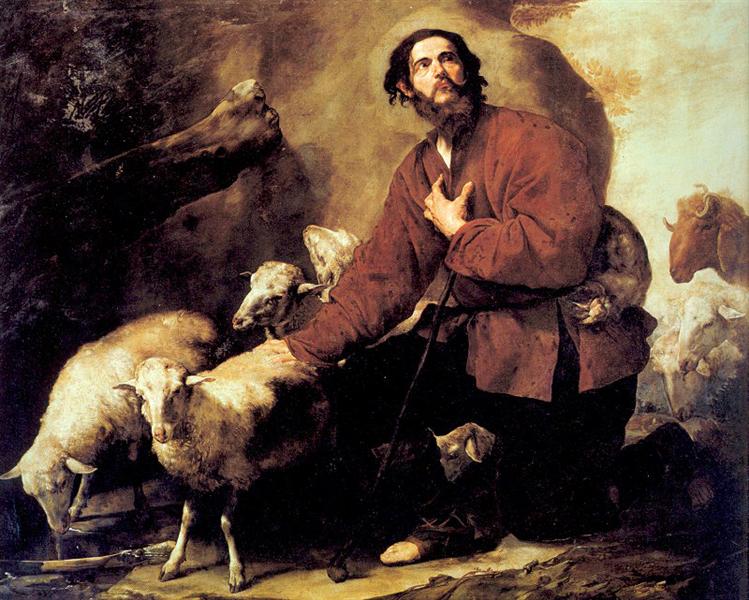
Jusepe de Ribera, (1591–1652)
Jacob With The Flock Of Laban
Oil on canvas
In addition to Leah and Rachel, Jacob married Silpa and Bilha, two members of Laban’s household:

Robert Vonnoh, (1858–1933)
Leah, c. 1923
Oil on canvas
116.21 X 116.21 cm
Robert William Vonnoh (September 17, 1858 – 28 December 1933) was an American Impressionist painter known for his portraits and landscapes. He traveled extensively between the American East Coast and France, more specifically the artists colony Grez-sur-Loing. He was born in Hartford, Connecticut. He studied in Boston at the Massachusetts Normal Art School now called Massachusetts College of Art and Design, then in Paris at the Académie Julian under Gustave Boulanger and Jules Joseph Lefebvre.
He taught at the Massachusetts Normal Art School (1879-1881), at the Cowles Art School in Boston (1884–1885), at the School of the Museum of Fine Arts, Boston (1883–1887), and at the Pennsylvania Academy of the Fine Arts (1891–1896). Vonnoh became a member of the National Academy of Design in 1906.
His most well-known work In Flanders Field (also known as Where Soldiers Sleep and Poppies Grow or Coquelicots) was painted in 1890 in the fields of Grez-sur-Loing. More

Maurycy Gottlieb, 1856 - 1879
Rachela
Maurycy Gottlieb (February 21/28, 1856 – July 17, 1879) was a Polish realist painter of the Romantic period. He was born in Drohobych to a wealthy family living in Galicia. It was then part of the Austrian sector of Partitioned Poland, now Western Ukraine. Considered one of the most talented students of Jan Matejko, Gottllieb died at the age of 23. More
Johann Carl Loth, (1632 – 6 October 1698)
Jacob, Rachel and Leah at the Well
Johann Carl Loth (1632 – 6 October 1698) was a German Baroque painter, born in Munich but active most of his life in Venice. He was the son and pupil of Johann Ulrich Loth (1590–1662) and was possibly influenced by Giovan Battista Langetti. He was commissioned to paint for the emperor Leopold I in Vienna. He worked together with Pietro Liberi in Venice, where he was during the years 1663-1698. His brother Franz Loth was also a painter in Venice and Germany. More
Giovanni Battista Tiepolo, 1696 - 1770
Bilhah and Zilpah
Bilhah and Zilpah
Detail From: Laban Looks for Idols, c. 18th
Udine, Italy
Giovanni Battista Tiepolo, Laban Looks for Idols, c. 18th, see below
Zilpah is given to Leah as a handmaid by Leah's father, Laban, upon Leah's marriage to Jacob (see Genesis 29:24, 46:18). According to some commentators, Zilpah and Bilhah, the handmaids of Leah and Rachel, respectively, were actually younger daughters of Laban, half-sisters of Leah and Rachel by different mothers.

Etienne Dinet, (1861 – 1929, French)
Bilhah and Reuben
Nasreddine Dinet (born as Alphonse-Étienne Dinet on 28 March 1861 – 24 December 1929, Paris) was a French orientalist painter. From 1871, he studied at the Lycée Henry IV, where the future president Alexandre Millerand was also among the students. Upon graduation in 1881 he enrolled in the École nationale supérieure des Beaux-Arts and entered the studio of Victor Galland. The following year he studied under William Bouguereau and Tony Robert-Fleury at the Académie Julian. He also exhibited for the first time at the Salon des artistes français.
Dinet made his first trip to Bou Saâda by the Ouled Naïl Range in southern Algeria in 1884, with a team of entomologists. The following year he made a second trip on a government scholarship, this time to Laghouat.[1] At that time he painted his first two Algerian pictures: les Terrasses de Laghouat and l’Oued M’Sila après l’orage.
He won the silver medal for painting at the Exposition Universelle in 1889, and in the same year founded the Société Nationale des Beaux-Arts along with Meissonier, Puvis de Chavannes, Rodin, Carolus-Duran and Charles Cottet. In 1887 he further founded with Léonce Bénédite, director of the Musée du Luxembourg, the Société des Peintres Orientalistes Français.
In 1903 he bought a house in Bou Saâda and spent three quarters of each year there. He announced his conversion to Islam in a private letter of 1908, and completed his formal conversion in 1913, upon which he changed his name to Nasr’Eddine Dinet. In 1929 he and his wife undertook the Hajj to Mecca. The respect he earned from the natives of Algeria was reflected by the 5,000 who attended his funeral on 12 January 1930 in Bou Saâda. There he was eulogized by the former Governor General of Algeria Maurice Viollette. More

Abel Pann, 1883-1963
The Four Matriarchs
Abel Pann (1883–1963), born Abba Pfeffermann, was a European artist who spent most of his adult life in Jerusalem. More
Leah bore him seven children: Reuben, Simeon, Levi, Judah, Issachar, Zebulun, and a girl, Dinah. Rachel, who was childless till the seventh year of their marriage, finally was blessed with a son, Joseph, and shortly before her death with another boy, called Benjamin. Jacob’s two other wives also bore him children; Bilha gave him Dan and Naphtali, and Silpa, Gad and Asher. The twelve sons of Jacob were to become the progenitors of the twelve tribes of Israel.

James Jacques Joseph Tissot, (French, 1836-1902)
Joseph Reveals His Dream to His Brethren, c. 1896-1902
The twelve sons of Jacob
Gouache on board
8 7/8 x 12 7/16 in. (22.6 x 31.6 cm)
The Jewish Museum, New York
Jacques Joseph Tissot (15 October 1836 – 8 August 1902), Anglicized as James Tissot, was a French painter and illustrator. He was a successful painter of Paris society before moving to London in 1871. He became famous as a genre painter of fashionably dressed women shown in various scenes of everyday life. He also painted scenes and characters from the Bible. More

Gerard Hoet, (1648-1733)
Jacob Blesses His Sons, c. 1728
Gerard Hoet (Dutch: [ɦut]; 22 August 1648 – 2 December 1733) was a Dutch Golden Age painter and engraver. Hoet trained with his father and brother who were glass painters, and Warnard van Rijsen, who lived in Zaltbommel, and who himself was a pupil of Cornelis van Poelenburgh in Utrecht. In 1672 Hoet moved to The Hague, but when the Count of Salis bought his paintings at his mother's house in Zaltbommel, Hoet returned to paint for him. More

Joseph Harry Anderson, (August 11, 1906 – November 19, 1996)
Jacob Blessing His Sons
Originally intending to be a mathematician, in 1925 while attending the University of Illinois, Joseph Harry Anderson discovered a talent and love for drawing and painting. In 1927, he moved to Syracuse, New York and attended the Syracuse School of Art with friend and fellow artist Tom Lovell for classical art education. He graduated in 1931 during the Great Depression and had difficulty making a living. Within a year he earned enough by doing art for magazines to return home to Chicago. By 1937 he was working on national advertising campaigns and doing work for several major magazines, such as Collier's, Cosmopolitan, Good Housekeeping, Ladies' Home Journal, Redbook, The Saturday Evening Post and others. More

Filippo Lauri, (Italian, 1623–1694)
Jacob Fleeing Laban, c. 1686
Oil on Canvas
Filippo's father had emigrated from Antwerp, and was a pupil of Paul Bril. Francesco's oldest brother Francesco Lauri was also a painter and a pupil of Andrea Sacchi, who died young. Fillipo often painted small figures for the landscapes of Claude Lorraine. He was prolific. He employed many engravers. More

Filippo Lauri, (Italian, 1623–1694)
Jacob fleeing from Laban
Oil on Canvas
94 x 110 cm. (37 x 43.3 in.)
Filippo Lauri (25 August 1623 - 12 December 1694), see above
The parting of Jacob and Laban came after Laban's sons began saying that, "Jacob has taken all that was our father's; and from what was our father's he has gained all this wealth." Apparently fearing that some sort of hostile action was about to be taken against him by his cousins and uncle.
While Laban was away shearing sheep Jacob fled suddenly back toward the home of his parents with all of his acquired family and wealth: his sons, his wives, his cattle, all his livestock... to go to the land of Canaan to his father Isaac." When Jacob and his wives departed for Canaan, Rachel in particular was still angry at her father for what he had done to her. Before they set out, she took the small figurines that represented the spirits of ancestors and the protective deities of her father's family
Laban Searching for the Idols
Oil on canvas
Pieter Lastman was born in Amsterdam, the son of a town-beadle, who was dismissed in 1578 for being a Catholic. His mother was an appraiser of paintings and goods. His apprenticeship was with Gerrit Pietersz Sweelinck, the brother of Jan Pieterszoon Sweelinck. Between approximately 1604 and 1607 Lastman was in Italy, where he was influenced by Caravaggio (as were the painters of the Utrecht School a few years later) and by Adam Elsheimer. Back in Amsterdam he moved in with his mother in the Sint Antoniesbreestraat, living next to mayor Geurt van Beuningen. Lastman never married although he promised to marry the sister of Gerbrand Adriaensz Bredero. Because of his health Lastman moved in with his brother in 1632. He died the next year and was buried in the Oude Kerk on 4 April 1633. More
Laban Searching for His Gods, c. 1647
Oil on oak panel
14 1/4 x 18 5/8 in. (36.2 x 47.3 cm)
Detroit Institute of Arts
Claes Corneliszoon Moeyaert or Nicolaes Moyaert or Mooyaert (1592–1655) was an authoritative Catholic Dutch painter born in Durgerdam. As a young man he is thought to have traveled to Italy to see and experience its art. At 25 he married Grietje Claes (in 1617). Possibly he was in business with Pieter Lastman in St. Antoniesbreestraat.
Moeyaert painted many biblical and mythological scenes, and also designed Amsterdam's triumphal arch for the arrival of Maria de Medici. On 1 September 1638, he stood on the Spaarndammerdijk to watch the procession.
Moeyaert was a very rich man and had three children, two mentally retarded and cared for in his own home. He had stakes in the business of Hendrick van Uylenburgh, a famous art dealer, related to Rembrandt's wife, Saskia van Uylenburgh.
Moeyaert was for many years' commissioner of the Theatre of Van Campen, with Jan Vos. He lived until his death at a house on the Singel, not far from Torensluis. Nicolaes Berchem, Salomon Koninck, Jacob van der Does and Jan Baptist Weenix were his pupils. More
Three days later, Laban discovered that Jacob had fled, and because Jacob had to move slowly with all of the family and flocks, Laban caught up to him. Although Laban may have originally planned to harm Jacob and take back all of his daughters, grandchildren and flocks,

Pietro da Cortona, (1596–1669)
Laban Seeking His Idols
Bristol Museum & Art Gallery
Attributed to Pietro da Cortona (Italian, 1596–1669), see above.

Giovanni Battista Tiepolo, 1696 - 1770
Laban Looks for Idols, c. 18th
Udine, Italy
Giovanni Battista Tiepolo (March 5, 1696 – March 27, 1770), also known as Gianbattista or Giambattista Tiepolo, was an Italian painter and printmaker from the Republic of Venice. He was prolific, and worked not only in Italy, but also in Germany and Spain.
Successful from the beginning of his career, he has been described by Michael Levey as "the greatest decorative painter of eighteenth-century Europe, as well as its most able craftsman." More
God intervened and warned Laban not to do anything to Jacob. Although Laban was an idol worshipper, he seems also to have known better than to disobey a direct command from The Lord.

Lodewyck Vay, (Dutch, 1630–d. after 1655)
The Reconciliation of Jacob and Laban
Oil on Canvas
196 x 267 cm. (77.2 x 105.1 in.)

Francesco Hayez, (1791–1882)
Esau and Jacob reconcile, c. 1844
Oil on canvas
208 × 300 cm (81.9 × 118.1 in)
Pinacoteca Tosio Martinengo, Brescia, Italy
Francesco Hayez (10 February 1791 – 21 December 1882) was an Italian painter, the leading artist of Romanticism in mid-19th-century Milan, renowned for his grand historical paintings, political allegories and exceptionally fine portraits. More

Peter Paul Rubens, (1577–1640)
The Reconciliation of Jacob and Esau, as in Genesis 33, c. 1624
Oil on panel
Scottish National Gallery
Sir Peter Paul Rubens (28 June 1577 – 30 May 1640) was a Flemish Baroque painter. A proponent of an extravagant Baroque style that emphasized movement, colour, and sensuality, Rubens is well known for his Counter-Reformation altarpieces, portraits, landscapes, and history paintings of mythological and allegorical subjects.
In addition to running a large studio in Antwerp that produced paintings popular with nobility and art collectors throughout Europe, Rubens was a classically educated humanist scholar and diplomat who was knighted by both Philip IV of Spain and Charles I of England. More
Artists: Master of Jean de Paris, François Maitre, Jan Victors, Gerard Hoet, Gioacchino Assereto, Matthias Stom, Hendrick ter Brugghen, José de Ribera, Govert Flinck, Joaquín Sorolla, Horst, Gerrit Willemsz, Gioacchino Assereto, Raphael, Louis Gauffier, Sebastiano Conca, Maestro dei dodici apostoli, Attributed to Pietro da Cortona, Restout, Jean II, Dante Gabriel Rossetti, Hendrick ter Brugghen, Joseph von Führich, Michelangelo, Giovanni Benedetto Castiglione, Robert Vonnoh, Maurycy Gottlieb, Johann Carl Loth, Giovanni Battista Tiepolo, Etienne Dinet, Abel Pann, James Jacques Joseph Tissot, Gerard Hoet, Joseph Harry Anderson, Filippo Lauri, Lastman, Pieter, Claes Cornelisz Moeyaert, Lodewyck Vay, Francesco Hayez, Peter Paul Rubens, Maestro dei dodici apostoli, Restout, Jean II,
Acknowledgement: Wayne Blank, Wikipedia,
Images are copyright of their respective owners, assignees or others










